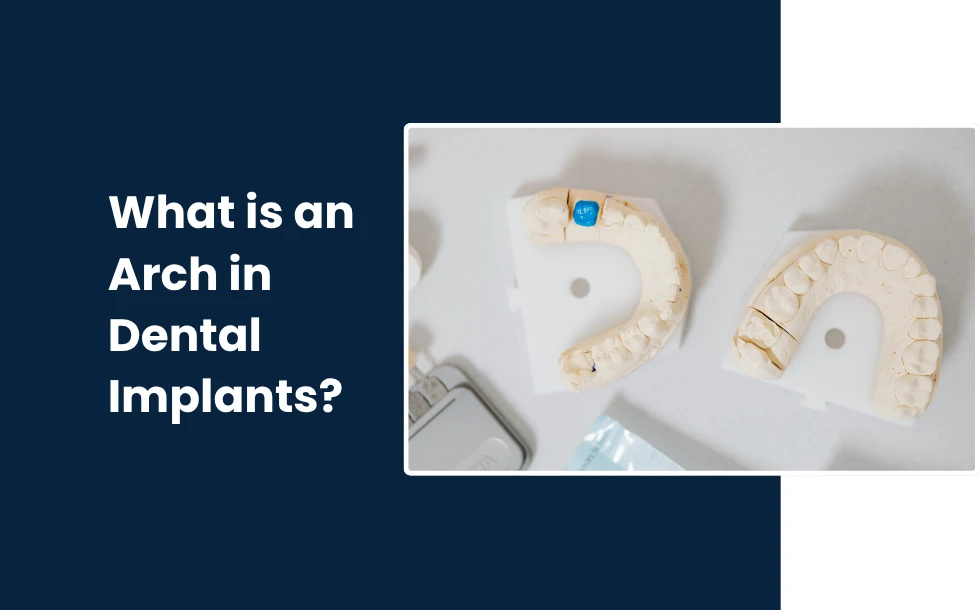If you are exploring options for replacing several or all of your teeth, you must have come across the term dental arch. Understanding what an arch in dental implants is will help you learn what this replacement procedure is and how it works in restoring a full upper or lower set of teeth.
In simple words, an implant arch is a complete set of teeth that replaces missing teeth in the upper or lower jaw, secured by several titanium posts placed in your jawbone. So, if you are missing adjacent teeth, it is the safest approach to a stronger bite, a beautiful smile, and lasting confidence. Let’s learn more about this.
Understanding the Dental Arch
Have you noticed how teeth are arranged in the mouth? The semi-circular, curved shape is called the dental arch. There are two arches in the mouth: the upper arch (maxillary) and the lower arch (mandibular).
Each arch in adults contains 16 teeth, including incisors, canines, premolars, and molars. Together, they create a balanced bite that supports speech, chewing, and facial structure. When teeth are lost, this harmony is disrupted, which is why full-arch implant systems are often recommended to restore both form and function.
Upper and Lower Arches
The upper arch connects to the maxilla and is slightly wider, while the lower arch sits on the mandible and moves during chewing. This difference is important in implant planning because the upper arch may need sinus evaluation, while the lower arch typically has denser bone for faster integration.
What an Arch Means in Dental Implants
In implant dentistry, an “arch” refers to a complete set of replacement teeth anchored by multiple implants. Instead of using one implant for every missing tooth, a few strategically placed titanium posts hold an entire upper or lower restoration securely in place.
This design restores natural bite strength, stability, and appearance while reducing treatment time and cost.
Full-Arch vs Partial Restorations
A full-arch restoration replaces all teeth in the upper or lower jaw using four to six implants. A partial-arch restoration targets one section of missing teeth, usually supported by fewer implants or an implant bridge. The choice depends on bone density, the number of missing teeth, and long-term treatment goals.
Types of Full-Arch Dental Implant Restorations
There are several ways to restore a full dental arch using implants. Your dentist will recommend the right approach based on your oral health, bone condition, and aesthetic goals.
All-on-4 Dental Implants
This method uses four titanium posts placed at specific angles in the jawbone to support a full-arch bridge. It is ideal for patients who want a permanent restoration without bone grafting. The angled placement provides stability even in areas with limited bone and allows faster healing and immediate function.
All-on-6 Dental Implants
All-on-6 uses six evenly spaced implants for greater strength and load distribution. It is often chosen for patients with sufficient bone density who want additional stability for long-term durability. The result is a fully functional arch that feels and looks like natural teeth.
Implant-Supported Dentures
This system combines the flexibility of dentures with the anchoring strength of implants. Multiple posts are integrated into the jawbone, and the custom denture securely snaps into place. It eliminates movement, improves chewing efficiency, and offers a more natural look than traditional dentures.
Upper vs Lower Arch Implants
Although both aim to restore full function, upper and lower implant arches differ slightly in anatomy and treatment approach.
- Upper Arch: The bone is less dense and often requires angled placement or a sinus lift for secure implant anchorage.
- Lower Arch: The bone is denser, allowing implants to integrate faster and provide immediate strength.
Understanding these differences helps the dentist plan precise implant positioning for maximum comfort and longevity.
Benefits and Considerations of Full-Arch Implants
Full-arch dental implants offer many life-changing benefits for patients missing most or all of their teeth.
Benefits
- Restores full chewing power and speech clarity
- Prevents bone loss and preserves facial structure
- Feels and looks like natural teeth
- Eliminates denture slipping and discomfort
- Long-term durability with proper care
Considerations
- Higher upfront cost compared to removable dentures
- May require bone grafting or sinus lift in low bone cases
- Longer healing and follow-up compared to single implants
- Each case is carefully evaluated through digital imaging and clinical assessment to ensure predictable results.
Cost, Recovery, and Longevity
The cost of a full-arch dental implant varies depending on the technique, number of implants, and materials used. On average, a single arch ranges from $15,000 to $35,000, while advanced procedures with zygomatic or grafting support may cost more.
Most patients return to daily activities within a few days after surgery, though full osseointegration typically takes three to six months. With good oral hygiene and regular dental checkups, full-arch restorations can last 20 years or longer. Cleaning under the bridge using interdental brushes or a water flosser helps prevent inflammation and maintain healthy gums.
FAQs
How many arches are in the mouth?
There are two arches, the upper (maxillary) and the lower (mandibular), each with 16 teeth in adults.
How many arches are restored in a full-arch dental implant?
A single arch restoration replaces all teeth in either the upper or lower jaw. Patients who have lost all teeth in both jaws can restore both arches for a complete smile.
Are full-arch implants worth it?
Yes. They provide long-term comfort, strength, and natural appearance, making them a lasting investment in oral health.
What is the recovery time for a full-arch implant?
Healing varies by patient but generally takes several months for complete bone fusion. Most people resume normal eating within a week after surgery.
Key Takeaway
A dental arch represents the natural curve of your teeth, and in implant dentistry, it refers to the full upper or lower restoration supported by multiple implants. Understanding how each arch functions and the available restoration options helps you make an informed choice for a healthy, confident smile.

